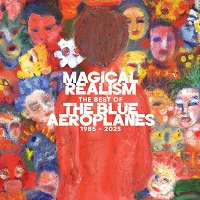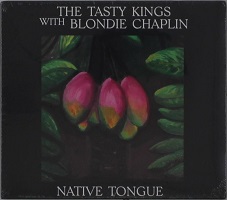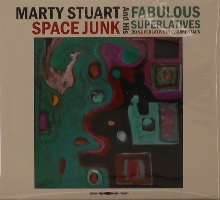| The Blue Aeroplanes: "Magical Realism: The Best Of The Blue Aeroplanes 1985 - 2025" (Chrysalis, Jan. 2025) |


 Mehr ...
Mehr ...
The Blue Aeroplanes sind die am längsten bestehende Band in Bristol und eine echte Art-Rock-Institution, die Generationen von Post-Punk- und Alternative-Gruppen wie R.E.M., Radiohead und Manic Street Preachers inspiriert hat. "Magical Realism - The Best Of The Blue Aeroplanes 1985-2025“ ist die erste von der Band kuratierte Anthologie, die Tracks aus ihrem gesamten Katalog enthält, neu gemastert von Phil Kinrade bei AIR Mastering. Die Sammlung enthält 23 Tracks, darunter Indie-Hymnen wie „...And Stones“ und „Jacket Hangs“, Fan-Favoriten wie die Klassiker „Fun“ und „Bury Your Love Like Treasure“ sowie neuere Songs wie „Dead Tree! Dead Tree!“, der zu einem Highlight der legendären Live-Sets der Band geworden ist. Außerdem sind zwei Bonustracks enthalten - 'Showing Off To Impress The Girls', eine Aufnahme der Vor-Blue Aeroplanes-Gruppe Art Objects, und 'I Will Love You', ein exklusives Demo eines brandneuen Songs. |
| The Tasty Kings with Blondie Chaplin: "Native Tongue" (Digital: Sept. 2023 * CD: Stand Clear, Jan. 2025) |
 Blondie Chaplin (1977)]
Blondie Chaplin (1977)]

 Mehr ...
Mehr ...
You likely know, or at least have heard, vocalist and guitarist Blondie Chaplin. He was a member of The Flames in the 1960s, and then The Beach Boys in the early 1970s. He also recorded with The Rolling Stones and The Band, as well as several other artists, and released a few solo albums. The guy has quite a music career. He joined The Tasty Kings for Native Tongue, which was released digitally in 2023, and has now gotten a proper CD release. Why it didn’t get a wide release initially is something I can’t fathom. It features excellent songs performed by accomplished musicians. The Tasty Kings were founded by guitarist Andrew Morse, who wrote the material on this album. The band has had several different members over the course of its history, and now includes Darryl Jones, who also plays bass in The Rolling Stones, and Charlie Sexton, who is known for his work with Bob Dylan and is also a member of Elvis Costello’s band. So, you know, this is a band you might want to pay attention to. This album also features the talents of Charley Drayton on drums (you know him from his work with Keith Richards), Kevin Trainor on guitar, Tony Garnier on bass, George Reiff on bass, Stephen Barber on piano and keyboards, Ian McLagan (of Small Faces) on keyboards (those tracks must have been recorded a while ago, as McLagan died in 2014), and Jose Galeano on percussion. Juliana Sheffield, Sally Allen and Teresa Gattison provide backing vocals. The album opens with “Done & Dusted.” There is a bit of a Rolling Stones vibe to this song, it taking place in that great meeting place of country, blues and rock. Blondie Chaplin delivers a good lead vocal performance. “Done and dusted/I’m just waitin’ to be/Done and dusted/Nothing left of me.” Andrew Morse wrote this one at the beginning of the pandemic, when everything was shut down and people were afraid to go out. It was a strange experience, to be sure, walking about in a usually-crowded area, and finding no one, the restaurants and everything closed. I remember driving at rush hour here in Los Angeles, and never having to hit my brakes. “Done and dusted/In the city that sleeps.” That’s followed by “Maybe I’m A Queen,” a stirring song, in which Blondie Chaplin sings, “Maybe I believe/Maybe I don’t/Maybe I’ll succeed/Maybe I won’t.” The repetition of the word “maybe” works so well, particularly as there are no certainties anymore. There is a sort of introspective bent to it, but then it turns outward, as it comes to address another person: “Tell me, my love, my love/When we were enough.” The song seems to encompass, or embrace, all possibilities, and so all people. It’s a beautiful and sad song, and Blondie Chaplin gives a passionate and beautiful vocal performance. Milo Deering plays dobro on this track, delivering some wonderful work. This is one of my personal favorites. Listening to “Birthday Girl” the first time, I couldn’t help but think of my niece, who had turned nineteen just two days earlier. How the time flies. “The years go by, that’s how it goes.” Indeed. There is a nice vibe about this song. “You’re the birthday girl/And the whole wide world loves you.” This is one of the tracks to feature Ian McLagan on keyboards. Then there is a more somber, but dreamlike quality to “South America” as it begins. And the first line hits us hard: “The Statue of Liberty has gone dark.” Yup, that is just about right. It’s a big line, isn’t it? It is interestingly followed by a somewhat more mundane and usual concern: “And there’s nowhere to park.” Certainly, that’s a common frustration, at least for those of us who live in cities. These lines make me think of that whiny sociopath currently occupying the White House: “And his big day was ruined/By the small size/Of his crowd.” But this song is not about that; rather it is a look back at a relationship that fell apart. There is a sad beauty to its sound, to its delivery. “And if just one more time/I could put my lips/On South America/I’d remember for a while/And die with a smile.” I love the guitar work on this track, particularly that lead in the second half. “Oceans Unfaithful” certainly has a Rolling Stones flavor, and its opening lines grab us: “The sky is right/The wind is wrong/The ocean’s unfaithful/But it won’t take long.” That idea, that image, of an unfaithful ocean is particularly wonderful. “Take my hand/Aces and eights/And lay your head/On the dinner plate/The world is stuck/In black and white/To live my life/In paradise.” That’s followed by “George Floyd.” There have been several songs written about George Floyd. His murder by the police sparked outrage in anyone with a pulse. It was yet one more bit of evidence that this country hasn’t really made any progress at all. If you need further proof of that, just look at who is in the White House now, and think of all the eager little fascists who put him back there. This is a strong and moving song. Here is a taste of the lyrics: “Well, two sets of rules/One black and one white/That’s the best we can do/As you beg for your life/A few on the ground/Tried to shut down/What they saw/But the men of the law/The men of the law/Oh, the men of the law.” This song does not end on an optimistic note, but rather an honest one: “But the river of evil/That runs through the hearts/Of the men/Will do it again/Again and again/And again.” “Flyboy” is a song touching on Greek mythology, particularly the story of Daedalus and his son Icarus. It has something of a sweet country flavor, and contains what is possibly the album’s best vocal performance. It is powerful and passionate, just fantastic, reminding me a bit of some of Richard Thompson’s work. And that performance is the main reason this track is another of the disc’s highlights. Here is a taste of the lyrics: “He considers the grace/And the shape of a bird/And tries to imagine/Escaping this earth/Slipping the bonds/Of the surly unkind/To go somewhere new/For the rest of his life.” The Tasty Kings then turn to a reggae groove for “Steady Reggie,” a song about a moving company. This one features John Mills joining the group on saxophone and Joel Diamond joining on keyboards, and also contains a lot of good stuff on guitar. “Kiss Me” has a sweet folk sound, featuring some pretty guitar work. After we’ve gotten comfortable in this wonderful music and atmosphere, Blondie sings the first line, “Maybe you should kiss me.” And there is so much joy in the room that a kiss sounds like exactly the right thing. Though, after a brief pause, he follows that line with this one: “Maybe you should dismiss me.” This is another of my personal favorites. It even contains a Shakespeare reference: “If all the world’s a stage/Maybe we should turn the page.” That reference is to Jacques’ famous speech from As You Like It, which begins “All the world’s a stage/And all the men and women merely players.” A kiss plays a part in “Girl Next Door” too: “But I remember/I kissed her once before/That girl next door.” This is another of the tracks to feature Ian McLagan on keyboards, and there is some really nice guitar work too. It’s a perfect conclusion to an excellent album. (Michael Doherty, michaelsmusiclog.blogspot.com, 14.03.2025) |
| Marty Stuart & His Fabulous Superlatives: "Space Junk - 20 Superlative Instrumentals" (Snakefarm, Vinyl: Apr. 2025 * CD: Nov. 2025) |

Marty Stuart und seine geniale Band haben sich für das neue Album dem Thema "Surf Musik" gewidmet. Und wenn ich mal von ein paar frühen Beach Boys Alben absehe, ist das hier tatsächlich meine erste Platte im Surf-Sound. Auf jeden Fall meine erste in deren typischer Variante ohne Gesang. Im April gab's das Album bereits auf Vinyl zum Record-Store-Day, war aber schwer zu kriegen und mir auch viel zu teuer. Jetzt ist eine bezahlbare CD erschienen, die ich mir zugelegt habe, immerhin im schönen Pappcover, zu desssen großartiger Ästhetik auch das verwenmdete Gemälde auf der Vorderseite beiträgt, das von niemand anderem als Herb Alpert stammt. Vermutlich wurde bei der gesamten Covergestaltung auch eine Platte aus den 60ern als Vorlage verwendet (wahrscheinlich etwas von A&M, denn Herb Alpert war das "A" in "A&M"!). Wenn mir einfällt welche, dann kann ich das Cover auch auf meine Seite mit "gecoverten" Plattencovers stellen.
Insgesamt eine tolle Platte mit toll klingenden Gitarre von Marty Stuart und Kenny Vaughan. Der fehlende Gesang wird nicht wirklich vermisst. (2025-12-15) 
 Mehr ...
Mehr ...
Marty Stuart Unveils Surf Guitar-Inspired Album “Space Junk”Marty Stuart and His Fabulous Superlatives have been experimenting with differing soundscapes over the last few records, exploring the sometimes psychedelic Cosmic Cowboy sounds inspired by The Byrds and other Country Rock bands of that late ’60s, early ’70s era. This time around they offer a take on ’60’s instrumental surf and Ennio Morricone Western soundtrack inspired sounds. The result is often breathtaking to behold. The first thing you notice with this vinyl-only Record Store Day release is the very striking cover art. It’s a painting from the famous Herb Alpert; yes that Herb Alpert, the jazz musician trumpeter known for his work with the Tijuana Brass, and a guy who’s performed on many soundtracks over the decades of his highly successful career. The artwork arrests your attention, much like the instrumental compositions contained within this exquisite two-record set of originals from Marty, “Cousin” Kenny Vaughan, “Handsome” Harry Stinson, and Chris Scruggs. Longtime fans of Marty Stuart’s live shows are used to hearing a few rousing surf-inspired instrumentals in the middle of his sets, so perhaps this album shouldn’t come as a total surprise. The surf music genre started in the late ’50s when a handsome, charismatic surfer in Long Beach California named Richard Monsour developed a striking instrumental guitar sound and technique that he hoped could convey the sound of waves in the ocean and the feeling when one is riding in them on a surfboard. He took a Fender Stratocaster and proceeded to blow up every amplifier he could get, playing it at high volume and creating an absolute sensation in youth culture everywhere. Monsour, who’s stage name was Dick Dale, had created a monster culture almost single-handedly, and a large number of surf bands popped up almost everywhere, cashing in on the sound. The Ventures among others took the sound all over the world and kids everywhere became guitar players, inspired by those magical sounds. Artists like Duane Eddy also made instrumental music popular as well. Italian composer Ennio Morricone who scored soundtracks to the so-called spaghetti western movies of Clint Eastwood like Hang Em High, The Good, The Bad and The Ugly, and A Fistful of Dollars, utilized a sound featuring Fender electric guitars, catchy melodies, and an orchestra to achieve a gritty sound designed to match the rugged western landscapes they were portraying in the movies. Then there was the John Barry-scored James Bond theme, which around the same time was creating a sensation. All of these sounds figure in to this album in one way or another. Marty Stuart and The Fabulous Superlatives never do anything halfway. The album is a labor of love and a major commitment of time, energy and passion. And it shows. So much attention has been given to detail on this record, from the collection of vintage instruments the band chose to record with, to the way the drums and amplifiers are mic’d. Longtime collaborator Mick Conley is once again heavily involved in the recording and engineering process, and sonically the album sounds terrific. Marty, Kenny and Chris have brought out the tools that guitar players doing vintage music absolutely relish, including use of tremelo, reverb, echo, baritone guitars, tremolo bars, and tube amplifiers. You can almost feel the reverberating tones coming off of Clarence, Marty Stuart’s Holy Grail 1954 Telecaster guitar, once owned by Byrds alumni and Kentucky Colonels founder Clarence White. The guitar, so prized among musicians as it featured the very first ever B-bender device installed, allows notes to be bent via a hidden mechanical device nestled into the body of the guitar and activated by a strap button which Marty controls. The resulting pedal steel style bends are startlingly effective, and this record showcases Marty Stuarts enviable lead guitar playing. Yet Space Junk also features songs written by all the band members, and they individually and collectively get a chance to shine. The album was recorded at multiple locations, including a couple studios around Nashville and the notable Capitol Studios in Hollywood. With Space Junk, Marty Stuart and The Fabulous Superlatives have successfully created an enviable collection of music that will feel right at home with surf fans, guitar enthusiasts, soundtrack junkies, Morricone devotees, western movie fans, musicians and music fanatics in general. It’s a bold, heady take on some vital but often overlooked genres in American music, and the end result is a wonderfully and perfectly-crafted album that years from now will still sound exciting. Marty Stuart is not ready to lie down and quit. He’s ever challenging himself, and in the process proving he has a lot left to offer. (Kevin Smith, SavingCountryMusic.com) |
| "The Power Of The Heart: A Tribute To Lou Reed" (Light In The Attic, April 2024) |


 Mehr ...
Mehr ...
»Für mich stach Lou heraus. Das einzig Wahre! Etwas Wichtiges für die amerikanische Musik und für alle Musik! Ich vermisse ihn und seinen Hund« - Keith Richards »Lou schien mir furchtlos zu sein, als würde er lieber sterben, als den Leuten zu gefallen. Davon habe ich mich inspirieren lassen.« - Rosanne Cash »Lou Reed ist mein frühester Einfluss, meine Einführung in den Punkrock. Dieser Song war eine großartige Gelegenheit, mit Maxim kreativ zu arbeiten.« - Angel Olsen »Lou Reed ist nun schon seit vielen Jahren tot. Er ist einer der wenigen Menschen, die ich jetzt genauso vermisse wie damals, als er ging. Es gibt so viele Momente, in denen ich mich frage, was er wohl sagen oder denken würde. Seine allgemeine Aura verlieh dem Raum immer etwas ganz Besonderes. Gott sei Dank hat er seine großartige Musik und seine Aufnahmen hinterlassen. Seine Persönlichkeit wird schmerzlich vermisst. Ich liebe dich, Lou.« - Rufus Wainwright Es versteht sich von selbst, dass der legendäre Lou Reed ein echter Rock'n'Roll-Pionier war. Seit dem Debüt von The Velvet Underground im Jahr 1967 und bis zum Ende seiner Tage sang Reed die Wahrheit aus seinem Herzen. Er lebte das Leben bis zum Äußersten - und dann noch etwas mehr. »The Power of the Heart« ist eine Hommage an Reeds Ausdrucksfreiheit mit Coversongs, die seine bahnbrechenden Jahre mit den Velvets bis hin zu seiner majestätischen Solokarriere umfassen. Jeder Titel ist eine glorreiche Erweiterung der Seele des Rock'n'Roll Animal, immer abenteuerlustig und avantgardistisch. The Power of the Heart: A Tribute to Lou Reed beginnt mit einer eigenen Legende, Keith Richards, der den Velvets-Klassiker I'm Waiting for the Man» neu interpretiert Richards' Interpretation lädt Sie sofort zu dieser unvergesslichen Reise ein. Im krassen Gegensatz dazu ist »Perfect Day« in der Bearbeitung von Rufus Wainwright mit sparsamem Fingerpicking und sanften Harmonien irgendwie noch melancholischer als das Original. Joan Jett and the Blackhearts liefern eine Version von »I'm So Free«, bei der selbst Lou im Grab schaukeln würde. Es ist aufregend, diese Songs von solchen Schwergewichten neu interpretiert und gesungen zu hören; man kann sogar hören, wie Lucinda Williams den Geist von Lou mit ihrer Version von »Legendary Hearts« kanalisiert Weitere bemerkenswerte Tracks sind das punkige, verliebte Duett des echten Liebespaares Angel Olsen & Maxim Ludwig mit »I Can't Stand It« und Rickie Lee Jones' Neuinterpretation von »Walk on the Wild Side«, die mit ihrem flüsternden Gesang, den reduzierten Perkussionsinstrumenten und einem Klavier, das sich für eine Late-Night-Lounge eignet, verführerisch wirkt. Dieses Tribute-Album lässt sich nicht in ein bestimmtes Genre einordnen, aber letztlich ist es das Herzstück: eine tief durchdachte Sammlung von Songs, die eine ganze Generation geprägt haben, und jeder einzelne ist eine Hommage an einen Mann, dessen Werk immer noch singt. |
Michaels aktuelle Plattentipps
| The Blue Aeroplanes: "Magical Realism: The Best Of The Blue Aeroplanes 1985 - 2025" (Chrysalis, Jan. 2025) |

 Mehr ...
Mehr ...
|
| The Tasty Kings with Blondie Chaplin: "Native Tongue" (Digital: Sept. 2023 * CD: Stand Clear, Jan. 2025) |
 Blondie Chaplin (1977)]
Blondie Chaplin (1977)]
 Mehr ...
Mehr ...
|
| Marty Stuart & His Fabulous Superlatives: "Space Junk - 20 Superlative Instrumentals" (Snakefarm, Vinyl: Apr. 2025 * CD: Nov. 2025) |

Marty Stuart und seine geniale Band haben sich für das neue Album dem Thema "Surf Musik" gewidmet. Und wenn ich mal von ein paar frühen Beach Boys Alben absehe, ist das hier tatsächlich meine erste Platte im Surf-Sound. Auf jeden Fall meine erste in deren typischer Variante ohne Gesang. Im April gab's das Album bereits auf Vinyl zum Record-Store-Day, war aber schwer zu kriegen und mir auch viel zu teuer. Jetzt ist eine bezahlbare CD erschienen, die ich mir zugelegt habe, immerhin im schönen Pappcover, zu desssen großartiger Ästhetik auch das verwenmdete Gemälde auf der Vorderseite beiträgt, das von niemand anderem als Herb Alpert stammt. Vermutlich wurde bei der gesamten Covergestaltung auch eine Platte aus den 60ern als Vorlage verwendet (wahrscheinlich etwas von A&M, denn Herb Alpert war das "A" in "A&M"!). Wenn mir einfällt welche, dann kann ich das Cover auch auf meine Seite mit "gecoverten" Plattencovers stellen.
Insgesamt eine tolle Platte mit toll klingenden Gitarre von Marty Stuart und Kenny Vaughan. Der fehlende Gesang wird nicht wirklich vermisst. (2025-12-15)  Mehr ...
Mehr ...
|
| "The Power Of The Heart: A Tribute To Lou Reed" (Light In The Attic, April 2024) |

 Mehr ...
Mehr ...
|


Alle diese geklärten und ungeklärten Details sind aber eher unwichtig, denn "Native Tongues" ist in jedem Fall ein gutes Rockalbum im Stil der 70er, guten Songs von Andrew Morse, gutem Gesang von Blondie Chaplin, guter Instrumentalarbeit der beteiligten Profimucker. Ausserdem hat natürlich die "Detektivarbeit" zu den "Knackigen Königen" Spass gemacht.
(2025-12-15)